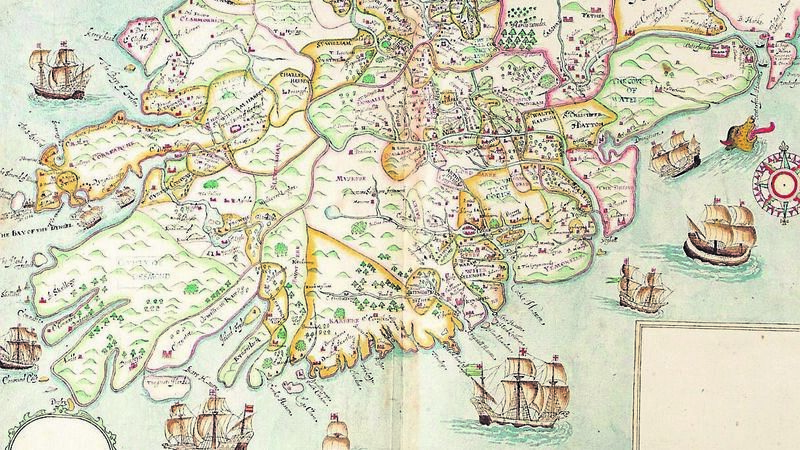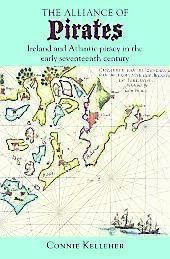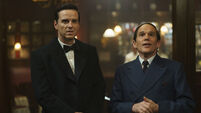Book review: The Alliance of Pirates regales with tales of plunder and piracy off the coast of Cork

Connie Kelleher's book The Alliance of Pirates' Figure 8. 'The Province of Munster, 1595' 18.15.31
TO anyone familiar with the waters around Baltimore, Cape Clear and Schull and their myriad islands, Connie Kelleher’s fabulous study on piracy is a revelation.
Did you know of a secret inlet near Castletownshend called Dutchman’s Cove with steps carved into the rocks so pirates could land their booty at night? Or the townland of Leamcon to the west of Schull which was a major pirate hub? Or that Baltimore itself so teemed with pirates that their ships were at anchor in the harbour as often as local vessels?
That pirate activity took place around there does not come as an eyeopener. We are familiar with the abduction of over 100 townsfolk from Baltimore by Algerine pirates in 1631, and the massacre of 600 people on Rathlin Island by Francis Drake.
That piracy took place at such a scale in West Cork is the mouth-agape moment. Of course Baltimore has its own monument to piracy in the shape of the restored O’Driscoll castle and tours; Sherkin has its Jolly Roger pub. There is much, much more than this.
The glossary in this book teems with nefarious possibilities: corsair, carbuncle, jolly roger, pieces of eight, privateer, Spice Islands. It forms an enticing avenue to discover the names and the events behind the myths.
It will come as no surprise to discover that things in this realm were not black and white. It wasn’t a case of pirates chasing down his majesty’s ships, plundering them and then in turn being chased by the crown. It was much more subtle than that with a gradation of involvement sometimes legal and sometimes illegal depending on the prevailing wind.
When King James I of England outlawed privately commissioned vessels in 1603 it displaced many seafarers who had earned a living by plundering vessels in the English Channel. The vice admiral of Devon, one Richard Hawkins, remarked that by attempting to remove the pirates from England he had simply dislodged them to Ireland. And many of these men had served with Drake and Walter Raleigh, the apotheosis of privateering.
The area comprised everything between Castlehaven to the east and Crookhaven in the West with enough sea passages, inlets, and caves in between to hide a fleet. The area had been a thorn in the side of the crown for hundreds of years by this stage and admirals had been appointed to “fight with god’s assistance the nation of the O’Driscolls, who constantly remain upon the westerly ocean preying on passing ships”.
Sometimes ships operated under ‘letters of marque’ which permitted a commissioned ship to sail into foreign waters to apprehend a ship of another country. Others operated under ‘letters of reprisal’ where captains could take to their home port a foreign ship. These were usually granted to ships which had been attacked so they could regain their property.
However, corruption followed in the wake of the privateers/ pirates and there was no end of port officials willing to turn a blind eye to illegal activities especially if a few sacks of spices or bottles of rum came their way. Smuggling, therefore, went hand in hand with piracy, as ready markets had to be found to offload the booty.
The title of Kelleher’s erudite study emanates from the necessity of the pirates to join together for a common interest. The inspiration was economic and the means was force of numbers and knowledge of the seas and coastline. The coast of West Cork was perfect for predatory attacks on passing ships. The alliance grew so powerful that its sphere of influence encompassed Baltimore to Mamora in Morocco and Newfoundland in present day Canada. Practically, any ship that passed in through those waters was fair game.

The pirates sailed smaller ships than the English navy’s and their pinnaces and barques would easily outrun the lumbering state ships.
An example of a plundered ship is the Grayhounde from La Rochelle in France which was attacked by William Baugh off Ireland. The pirates made off with: “28 bolts of Holland [cloth]; vi pieces of silver; certain silver and gold wire; certain satin; velvette & damaske in bolts; 170 bolts of silk garters.”
Baugh was one of the leading lights of the alliance and would have been known to several of the pirates who plied the high seas in West Cork and also included: John Jennings, James Harris, William Harvey, Gilbert Roope, Tibalt Suxbridge, Robert Stephenson and Robert Walsingham. These were all English pirates.
Also prominent was Irishman Patrick Myagh who was slain along with two of sons in a Dutch attack under the ruthless captain Moy Lambert on Crookhaven in 1614. The Dutch had been petitioning the English for years for permission to attack the pirates in their bases and when the English finally relented, Myagh was dealt a fatal blow. There is still evidence of the pirates’ constructions near the village in the form of a quay.
Hull’s liaison with pirates “supplemented his escalating prosperity through his tenure as deputy vice admiral” and from his castle, rented from the O’Mahony’s, was able to expand his business interests which included land, fishing and booty. One deposition to the High Court of Admiralty denounced him as “a notorious harboror of piratts and receavor of theire goodes”.
Kelleher describes Leamcon as having a cosmopolitan existence, where international currencies were in use and multinational crews sailed in to port.
A letter received by the Earl of Salisbury in 1611 mentioned the prospect of hidden treasure in the area: “In the harbor at Long Ilande near Limcolme that which altogether passeth here - is rialls of 8, Barbary ducketts & dollars, and yt is thought som treasure here buried on land by some of the pirates”.
Perhaps it still lies there in an overgrown sinkhole.
One of the pirate centres in Baltimore was the tiny inlet of Tramadroum, facing Sherkin lighthouse, where they would tie up their boats. There is evidence here too of a quay, slipway and cobbled trackway. Cape Clear is mentioned in a Dutch document as “the pirate havens on Cabo Cler”.
So frustrated was the crown that at one stage an enforced depopulation of the islands was considered to defeat the scourge of piracy. As the decades passed, the English navy was beginning to get stronger and there was more of a concerted effort to bring piracy to an end. Many pirates were pardoned, some were hanged in chains, yet others found their way with the king’s blessing to the New World where opportunities were opening up.
A power vacuum was created into which the Algerine pirates would later sail at great cost to the people of Baltimore.
The reader can search and search in this riveting book for a flaw, but you would be quicker finding a pirate’s treasure hoard.





